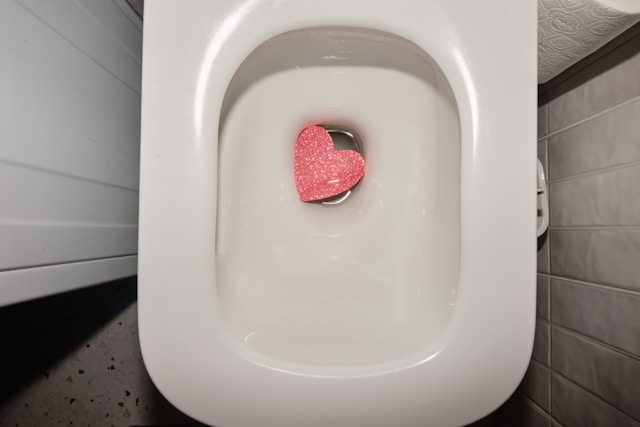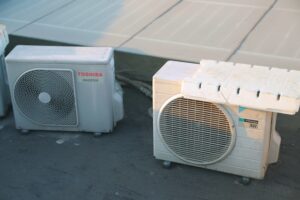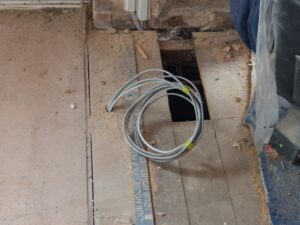Dealing with a toilet that isn’t flushing, but isn’t clogged, can feel like a mystery. You’re staring at it, and everything seems fine, but that flush just won’t happen.
So, what could be going wrong?
Often, the culprit is something as simple as the flapper. This small piece at the bottom of the tank releases water into the bowl when you flush. If it’s not sealing properly, you might still get water flowing, but not enough to flush properly. It’s like the toilet is trying to flush but just isn’t quite making it.
Another common issue can be the fill valve. If the valve is malfunctioning, it won’t fill the tank with enough water, and without that, your flush just won’t have the power it needs. Think of the fill valve as the gas pedal — if it’s not working right, you won’t get very far.
It could also be something as simple as the lift chain. The flush mechanism might not work properly if it’s too tight or too loose. Adjusting the chain can sometimes solve the problem in a snap.
If all of this sounds a bit too tricky or you’re just not in the mood to get your hands wet, don’t worry. Sometimes the best solution is a professional touch. Excel Mechanical is here to help with expert plumbing services, ensuring your toilet flushes like it should.
In this blog, we’ll talk about:
- Understanding the toilet flush mechanism and its key components.
- Common reasons for flush failure and how to address them.
- Simple troubleshooting steps and when to call in the pros.
Let’s go in-depth!
Understanding the Toilet Flush Mechanism
A toilet flush mechanism is essential for proper functioning. It involves several parts that move water from the tank to the bowl.
Key Components:
- Flush Handle: Activates the flushing process.
- Lift Chain: Connects the handle to the flapper.
- Flapper: Releases water from the tank.
- Overflow Tube: Prevents overflow and maintains water level.
Each part plays a vital role in flushing.
When you flush, the handle lifts the chain, raising the flapper. This action releases water into the bowl, creating the flush. If any part malfunctions, the flushing may not work properly. It’s crucial to check these parts if you have issues.
Common Reasons for Flush Failure
A toilet failing to flush can be annoying, especially when it’s not clogged. Several common causes might be to blame.
- Faulty Flapper: The flapper is a crucial part of the toilet tank. If it is damaged, water won’t flow properly. Ensure it seals well and is not stuck.
- Chain Issues: If the chain connecting the flapper to the flush handle is too long or too short, the flapper won’t rise properly. Adjust the chain to the right length for smooth operation.
- Low Water Level: The tank’s water level should be around an inch below the overflow tube. If it’s too low, check the fill valve or float to allow more water in.
- Mineral Buildup: Mineral deposits can block the rim holes under the toilet bowl’s edge, reducing the flushing power. Clean the holes using a wire hanger or specialized cleaner.
- Blocked Rim Jets: These jets are responsible for flushing power. If they’re blocked, the toilet will not flush efficiently. Regular cleaning helps maintain performance.
- Malfunctioning Lift Chain: The lift chain should have the correct tension and length for the proper function. Monitor and adjust it regularly.
For reliable plumbing advice, we stand out as the best choice. Our team deeply understands these issues, providing tailored solutions for your budget and needs. Whether residential or commercial, we ensure reliable service with outstanding quality, aimed at resolving any flushing issues swiftly and efficiently.
Initial Troubleshooting Steps
When your toilet isn’t flushing but isn’t clogged, check a few areas before calling for help.
- Start by removing the tank lid and inspecting the handle and chain. A broken handle or chain not connected properly can prevent the flapper from lifting. Adjusting or replacing these parts can often solve the issue.
- Next, look at the water level in the toilet tank. Ideally, it should be about an inch below the top of the overflow tube. If it’s low, adjust the float using the screw or clip mechanism to allow more water to fill the tank.
- Check the flapper valve to ensure it is sealing correctly. A worn-out or warped flapper can cause water to leak or not seal properly. Replacing the flapper is a simple fix that can improve flushing.
- If these steps don’t help, consider the fill valve. If it’s not working correctly, it might need cleaning or replacement. Follow instructions to remove and clean any debris from the valve carefully. If it’s old, consider replacing it.
For persistent issues, seeking professional help may be the best action. At Excel Mechanical, our team excels in providing top-notch HVAC and plumbing services. We can offer expert solutions tailored to your needs and budget.
Manual Inspection of Toilet Components
A manual inspection of key components is crucial to fix a toilet that isn’t flushing properly but isn’t clogged. To identify potential issues, check the flush handle, lift chain, fill valve, and rim jets.
Check the Flush Handle and Actuator
Begin by observing how the flush handle operates.
When you press it, it should move smoothly. The handle is connected to an actuator inside the tank. If the handle feels loose or doesn’t return to its original position, there might be an issue with the actuator.
Check where the handle connects. Tighten any loose screws and make sure the handle isn’t cracked. A broken handle needs replacing. The actuator lever arms should align properly with the flush mechanism.
Also, make sure nothing is blocking the actuator from moving. Sometimes, cleaning mineral buildup can resolve minor problems. If adjustments don’t help, you might need to replace the handle or the actuator for better results.
Inspect the Lift Chain or Flapper
Lift the toilet tank lid to check the lift chain and flapper.
The chain connects the flush handle to the flapper, which controls water flow from the tank to the bowl. Ensure the chain has enough slack to lift the flapper but is not too loose.
Observe the flapper’s position. The valve seat should have a tight seal. Mineral deposits or warping can prevent a snug fit, reducing water flow. If the flapper is worn or damaged, it might not seal the valve properly, leading to flushing issues.
Adjust the chain length as needed. If it’s rusted or broken, consider replacing it.
Examine the Toilet Fill Valve
The fill valve controls the amount of water entering the tank after a flush.
Check that the valve and float move freely and aren’t stuck. Ensure the float height is set correctly for the tank’s appropriate water level.
Sometimes, debris can clog the fill valve, affecting water flow. Turn off the water supply and remove the valve cap to clean any debris inside. Test the valve by flushing the toilet and watching how water fills the tank.
Proper adjustment and cleaning of this component ensure effective flushing. If necessary, replace worn parts to avoid recurring issues.
Assess the Toilet Bowl and Rim Jets
Examine the bowl closely.
Ensure that it is free of damage, such as cracks or leaks, that could affect the flushing efficiency. The rim jets, located under the bowl’s rim, allow water to enter during a flush.
Mineral deposits can clog these jets, impacting water flow and flushing strength. Use a thin wire or brush to clean them. Periodically cleaning these jets keeps the toilet functioning well.
Check the consistency of the water flow from the jets during a flush. If the rim jets remain clogged, consider professional plumbing assistance. Keeping these components clean and well-maintained will promote efficient flushing.
Advanced Diagnostics
Resolving a toilet that doesn’t flush but isn’t clogged involves specific checks. It’s crucial to investigate silent leaks, assess the water level, and inspect the overflow tube to understand and effectively fix the problem.
Testing for Silent Leaks
Silent leaks in a toilet can waste significant amounts of water and prevent proper flushing.
To check for these, add a few drops of food coloring to the tank and wait about 15 minutes without flushing.
If colored water appears in the bowl, there’s a leak. Often, a worn-out flapper causes such leaks. Replacing it can stop the leak and improve your toilet’s flush efficiency. Regularly checking for silent leaks can also ensure effective water conservation in your home.
Evaluating the Water Level in the Tank
The water level in the tank is key for a strong flush.
If it’s too low, the toilet won’t flush effectively. Inspect the tank’s fill line. It’s usually marked on the inside.
If the water doesn’t reach this line, adjust the float. The float controls the water level. Depending on your toilet model, it can be adjusted with a simple twist or slide. Ensure the water level meets the fill line for the best flushing power.
Inspecting the Overflow Tube
The overflow tube maintains the tank’s water level.
If it malfunctions, it might continuously leak water into the bowl or cause flushing issues. Check that the overflow tube is intact and properly attached.
Make sure it’s directing excess water into the bowl as intended. If it’s damaged or disconnected, the toilet may not flush correctly. It must be repaired or replaced to prevent constant water flow issues.
Unclogging Techniques Without a Plunger
When you don’t have a plunger nearby, there are still effective ways to tackle a stubborn toilet. You can often solve the problem quickly and easily using common household items and simple tools.
Hot Water and Dish Soap Method
A common method to clear a toilet without a plunger involves hot water and dish soap.
Begin by squirting a generous amount of dish soap into the toilet bowl. Let it sit for about 10 minutes to help lubricate any obstructions.
Next, heat a pot of water until it’s hot, but not boiling, as extremely hot water can crack porcelain. Carefully pour the water into the toilet bowl from waist height. The force of the water, combined with the lubricating effect of the soap, may help dislodge the blockage.
Wait a few minutes, then attempt to flush. This method works best for minor clogs.
Baking Soda and Vinegar Combination
Another technique involves baking soda and vinegar.
Start by pouring one cup of baking soda into the toilet bowl. Follow this with a cup of vinegar, pouring slowly to avoid overflowing.
The mixture will fizz and create a reaction that can help break down clogs. Let it sit for about 20-30 minutes. If the water level goes down, try flushing the toilet. This method is effective for soft, biodegradable clogs and might need repeating for tougher jams.
It’s a chemical-free solution uses everyday items you likely have at home.
Closet Auger Usage
A closet auger can be a valuable tool for handling more stubborn clogs.
It’s designed for toilets and can reach deeper than a regular snake. To use it, insert the auger into the toilet bowl, directing it into the drain.
Feed the cable through until you feel resistance. Then, crank the handle to break up or retrieve the clog. Slowly pull the auger out of the toilet, checking if the obstruction is attached. The closet auger can handle more challenging clogs effectively, offering a mechanical advantage over other methods.
Maintenance Tips to Prevent Future Issues
To keep your toilet functioning smoothly and avoid problems, it’s essential to perform regular cleaning, check components periodically, and practice water conservation. Following these steps can prevent many common toilet issues.
Regular Cleaning Recommendations
Keeping your toilet clean is key to preventing issues.
Regular cleaning can stop mineral buildup and prevent odors. Use a mild toilet cleaner weekly to remove stains and bacteria.
To clean under the rim, use a toilet brush to scrub gently. Avoid using harsh chemicals, as they might damage parts or cause leaks.
Don’t forget about the exterior surfaces, including the tank and handle. Regular cleaning prevents grime and keeps your toilet looking new.
Periodic Component Checks
Checking the components inside the toilet tank can prevent problems.
Inspect the flapper every few months to ensure it’s sealing properly. A faulty flapper can lead to constant running water or incomplete flushing.
Check the fill valve and float to ensure they are functioning correctly. Listen for unusual sounds, such as hissing, which can indicate a leak. Tighten any loose connections to avoid leaks.
Also, inspect for cracks in the tank or bowl. Early detection of these issues can help avoid costly repairs.
Water Conservation Practices
Conserving water is not only eco-friendly but also helps maintain your toilet. Try installing a dual-flush system to save water on small flushes.
Check for leaks by adding food coloring to the tank. If the color appears in the bowl without flushing, there may be a leak. Fixing leaks can save significant amounts of water.
Consider using a water displacement device in the tank to reduce water per flush. Just be sure it doesn’t interfere with the flushing mechanism.
When to Call a Professional Plumber
Sometimes, toilet problems go beyond simple fixes.
If your toilet won’t flush but isn’t clogged, it might be time to get expert help. Complex issues involving parts like the flush valve or the internal plumbing system can arise. In such cases, a professional can assess and resolve the problem effectively.
Consider calling a plumber if you notice any of the following:
- Toilet Makes Strange Noises: If there are unusual sounds when flushing, like gurgling or hissing.
- Weak Flush: Continuous weak flushing might be due to problems with the toilet’s mechanics.
- Water Level Problems: Fluctuating water levels in the bowl or tank could indicate a more serious issue.
Ignoring plumbing signs can lead to larger issues. If basic troubleshooting doesn’t work, it’s time to trust a professional. Excel Mechanical offers reliable and efficient solutions to prevent further damage or inconvenience.
Don’t hesitate to reach out to ensure your plumbing system operates smoothly.
Conclusion
When your toilet won’t flush but isn’t clogged, there are a few things you might consider checking. Make sure the water level in the tank is adequate. If it’s too low, your toilet might not have enough power to flush properly.
Examine the flapper to ensure it seals correctly. Leaks around the flapper can affect the flush. Replacing a worn-out flapper can often solve the problem.
Look at the lift chain inside the tank. If it’s too loose or broken, the flapper won’t open fully, impacting the flush. Adjust or replace it if needed. Ensure that the overflow tube is not cracked. Damage to this part can lead to flushing problems as it helps regulate water flow.
It could be a more complex issue if these fixes don’t work. You might need professional help. This is where choosing a trusted service like Excel Mechanical becomes important.
Why Choose Excel Mechanical?
- Expertise: We provide top-quality HVAC and plumbing services.
- Customization: We tailor solutions to fit your budget and needs.
- Reliability: We strive for exceptional quality to ensure your satisfaction.
When dealing with plumbing challenges, relying on Excel Mechanical ensures you receive professional service for both residential and commercial needs. Our expertise helps you address any issues effectively and efficiently.
Frequently Asked Questions
Toilet problems can leave you scratching your head, especially when it won’t flush but isn’t clogged. Let’s answer some common questions about this issue and guide you through what might be going wrong—and how to fix it.
What steps can I take if my toilet fills up with water but does not flush?
If your toilet fills with water without flushing, it might be due to a problem with the flapper or float. Check for any damage to these parts and ensure the tank’s water level is adjusted correctly. Adjust the chain connected to the flapper to ensure it lifts properly.
How can I fix a dual flush toilet that isn’t flushing properly?
For dual flush toilets, check the seal in the flush mechanism. If it’s not sealing correctly, it might need cleaning or replacement. Also, ensure that the toilet buttons are not stuck. You could try adjusting the water level for a more effective flush.
What should I do if my toilet bowl water rises but doesn’t drain or flush?
This issue may be due to a problem with the vent stack or an incomplete flush cycle. Ensure the venting system is clear and inspect the flush valve for debris or damage. If these solutions don’t work, consult a professional.
How can I diagnose a toilet that isn’t flushing despite no obvious clogs?
Look at the main components of the toilet tank like the flapper, fill valve, and overflow tube. Each should work properly, with no signs of wear or damage. If one part is malfunctioning, it might need repair or replacement.
What could be the reason for a toilet not to flush even though there’s no water in the tank?
When there’s no water in the tank, a broken fill valve is often the cause. Check if the water supply line is properly connected and open. If the valve seems defective, consider replacing it. Also, inspect for leaks that prevent water from staying in the tank.
What are common solutions to fix a toilet that won’t flush solids?
First, adjust the tank’s water level to ensure the flush is powerful enough. Then, check for any blockage in the siphon jet holes under the rim. If the problem persists, you might need professional assistance.




